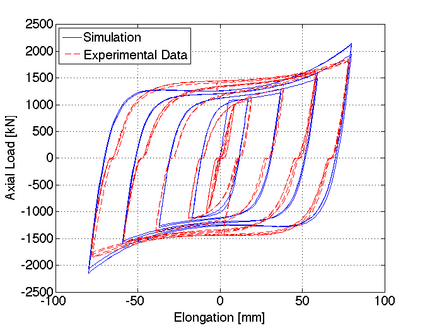CastFuse Material
Jump to navigation
Jump to search
- Command_Manual
- Tcl Commands
- Modeling_Commands
- model
- uniaxialMaterial
- ndMaterial
- frictionModel
- section
- geometricTransf
- element
- node
- sp commands
- mp commands
- timeSeries
- pattern
- mass
- block commands
- region
- rayleigh
- Analysis Commands
- Output Commands
- Misc Commands
- DataBase Commands
This command is used to construct a CastFuse uniaxial material. The CastFuse material simulates the hysteretic response a cast yielding fuse (CSF) for concentrically braced frames. The details of a CSF-brace are discussed in Gray et al. [1,2]. Isotropic hardening is modeled with the rules developed by Filippou et al. [3].
| uniaxialMaterial Cast $matTag $n $bo $h $fy $E $L $b $Ro $cR1 $cR2 <$a1 $a2 $a3 $a4> |
| $matTag | integer tag identifying material |
| $n | Number of yield fingers of the CSF-brace |
| $bo | Width of an individual yielding finger at its base of the CSF-brace |
| $h | Thickness of an individual yielding finger |
| $fy | Yield strength of the steel material of the yielding finger |
| $E | Modulus of elasticity of the steel material of the yielding finger |
| $L | Height of an individual yielding finger |
| $b | Strain hardening ratio |
| $Ro | Parameter that controls the Bauschinger effect. Recommended Values for $Ro=between 10 to 30 |
| $cR1 | Parameter that controls the Bauschinger effect. Recommended Value $cR1=0.925 |
| $cR2 | Parameter that controls the Bauschinger effect. Recommended Value $cR2=0.150 |
| $a1 | isotropic hardening parameter, increase of compression yield envelope as proportion of yield strength after a plastic deformation of $a2*(Pp/Kp) |
| $a2 | isotropic hardening parameter (see explanation under $a1). (optional default = 1.0) |
| $a3 | isotropic hardening parameter, increase of tension yield envelope as proportion of yield strength after a plastic deformation of $a4*(Pp/Kp) |
| $a4 | isotropic hardening parameter (see explanation under $a3). (optional default = 1.0) |
| Gray et al. [1] showed that the monotonic backbone curve of a CSF-brace with known properties (n, bo, h, L, fy, E) after yielding can be expressed as a close-form solution that is given by, |
| P = Pp/cos(2d/L), in which d is the axial deformation of the brace at increment i and Pp is the yield strength of the CSF-brace and is given by the following expression |
| Pp = nboh2fy/4L |
| The elastic stiffness of the CSF-brace is given by, |
| Kp = nboEh3fy/6L3 |
Examples:
References:
| [1] | Gray, M.G., Christopoulos, C., Packer, J.A., (2010). "Cast Steel Yielding Fuse for Concentrically Braced Frames," Proceedings of the 9th U.S. National and 10th Canadian Conference on Earthquake Engineering, July 25-29, 2010, Toronto, Ontario, Canada, paper No. 595. |
| [2] | Gray, M.G., Christopoulos, C., Packer, J.A., Lignos, D.G. (2012). "Development, Validation and Modeling of the New Cast Steel Yielding Brace System,” Proceedings ASCE Structures Congress, March 29th-31st, Chicago, IL, USA, SEI institute. |
| [3] | Filippou, F. C., Popov, E. P., Bertero, V. V. (1983). "Effects of Bond Deterioration on Hysteretic Behavior of Reinforced Concrete Joints," Report EERC 83-19, Earthquake Engineering Research Center, University of California, Berkeley. |
Code Developed by : by Dr. Dimitrios G. Lignos, (McGill University)
